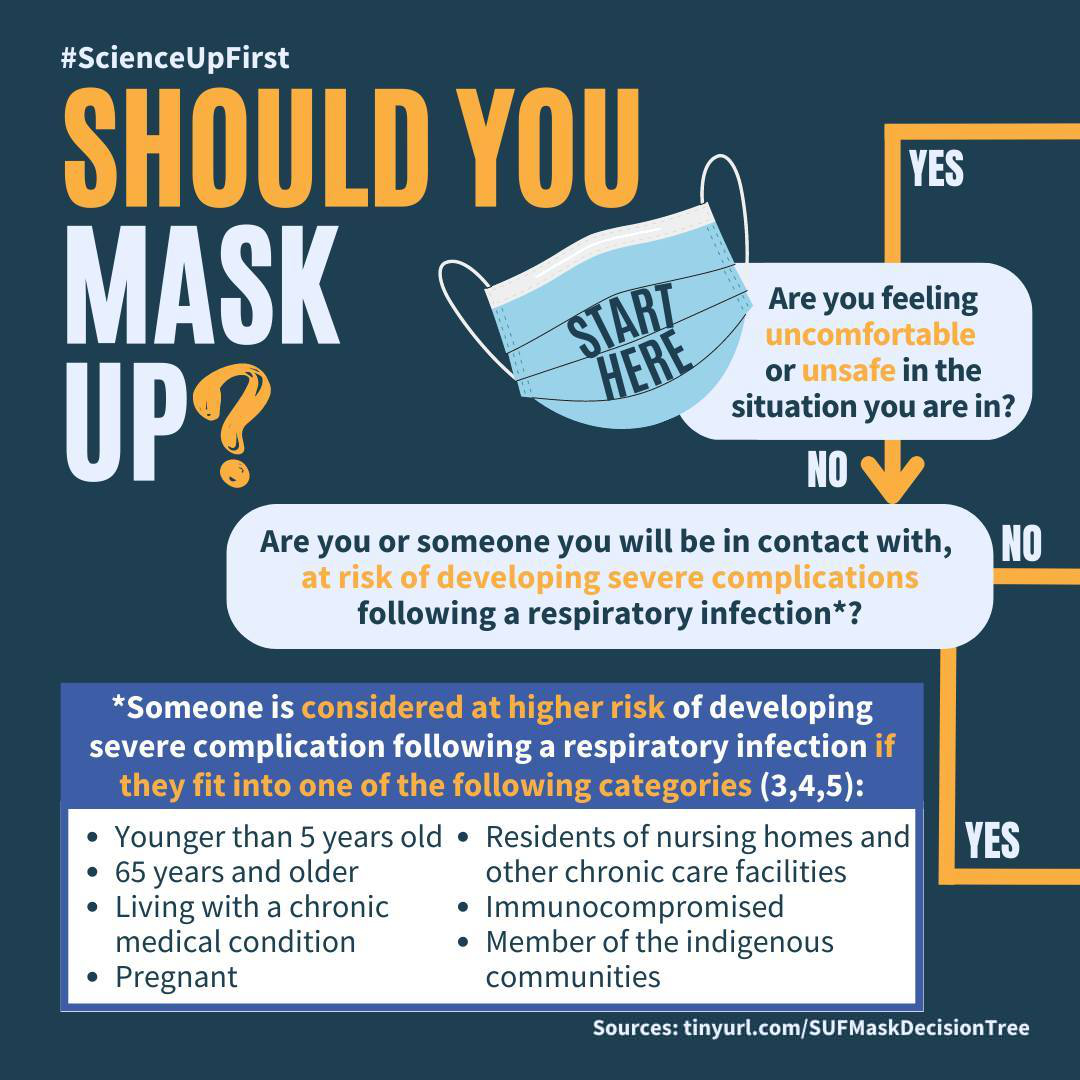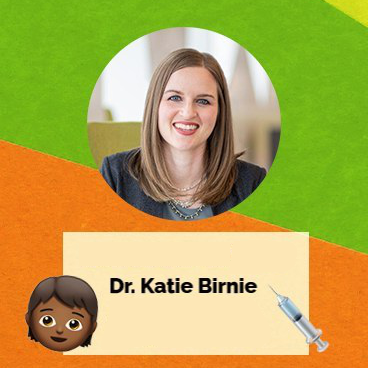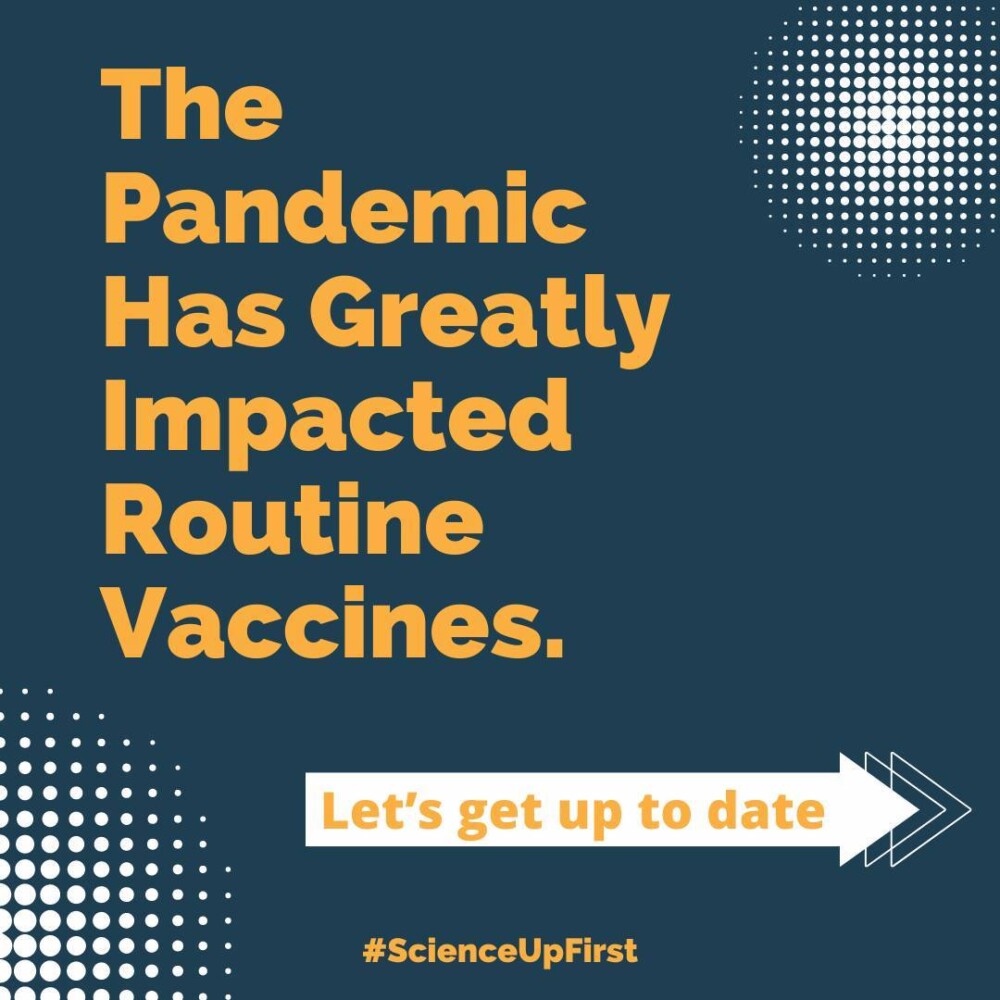
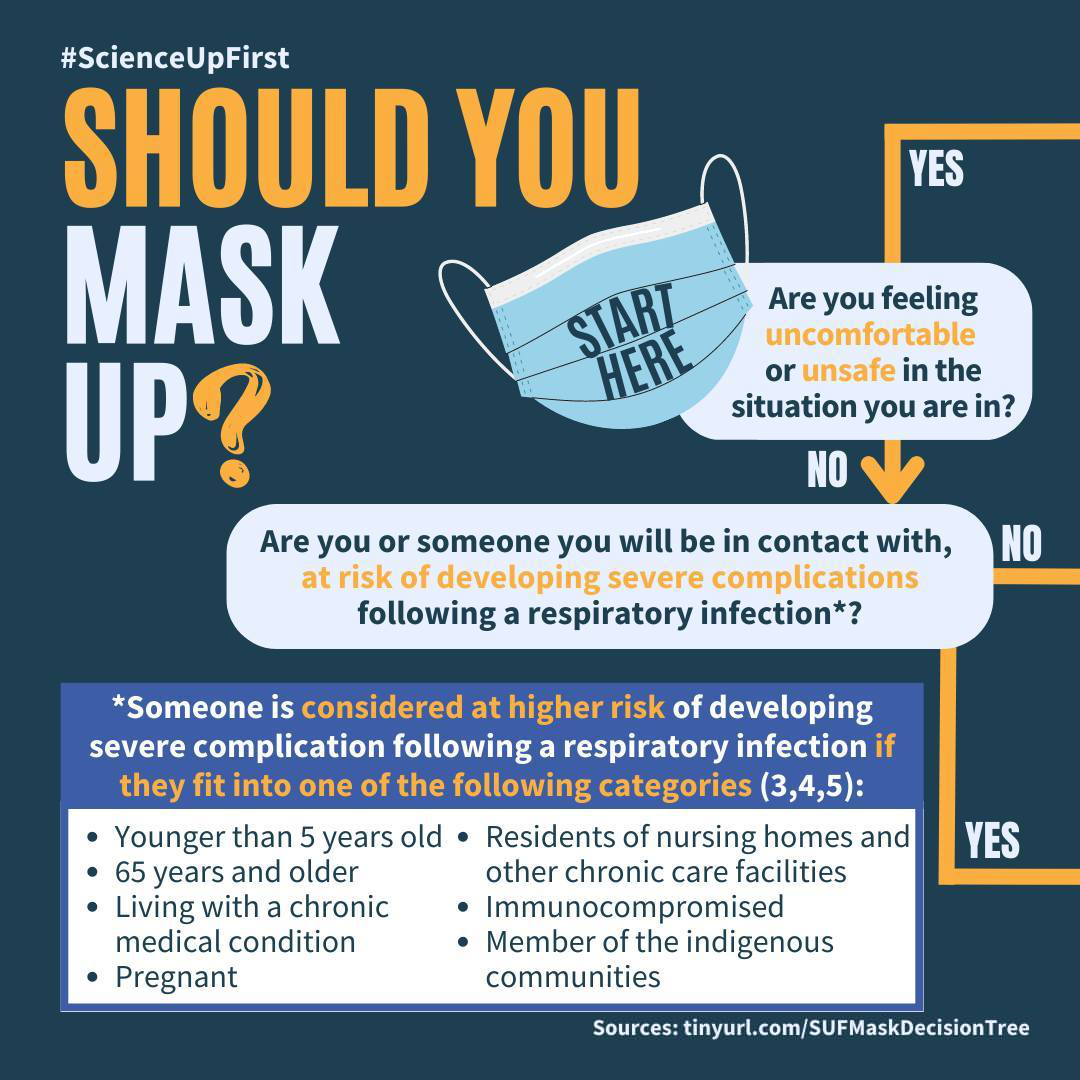
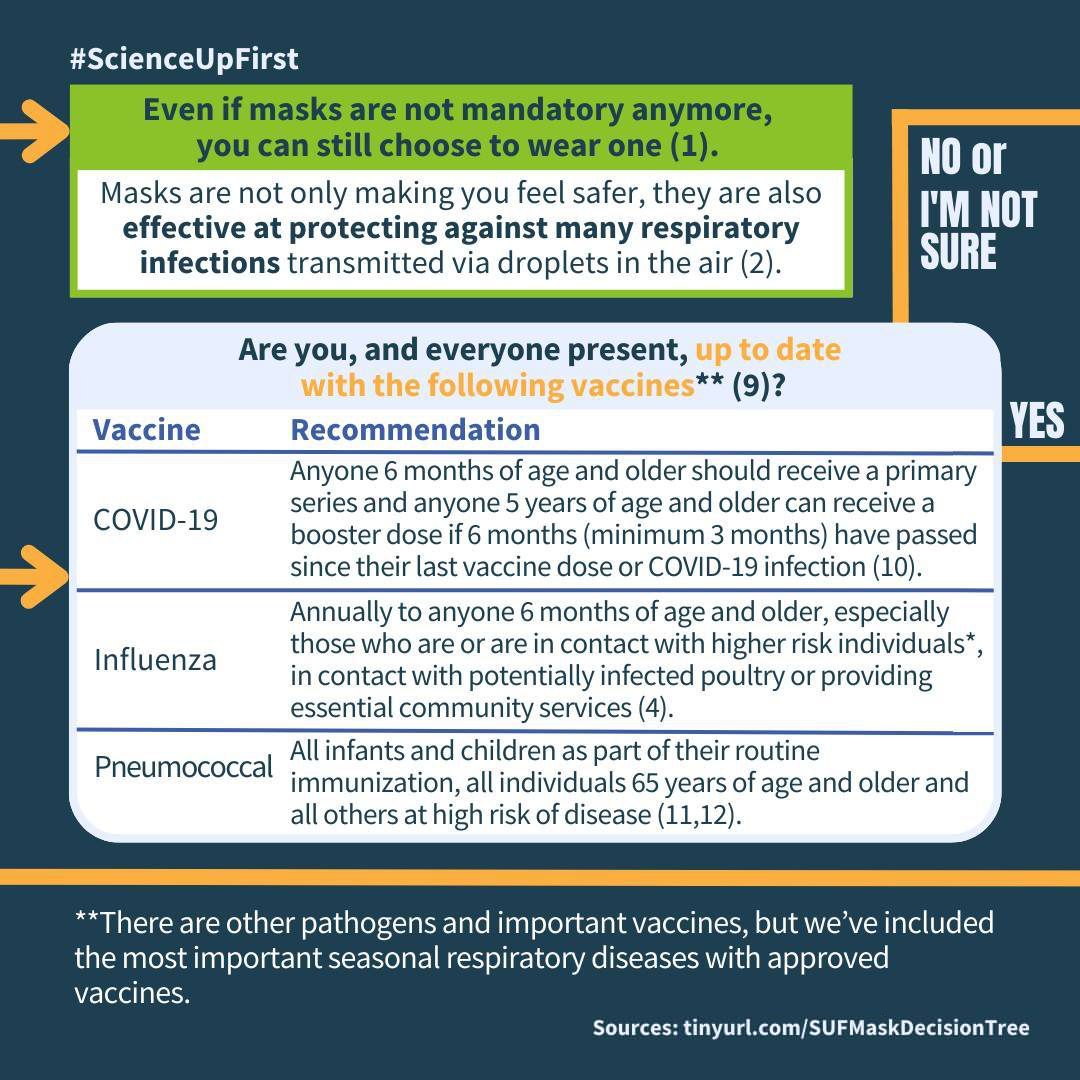
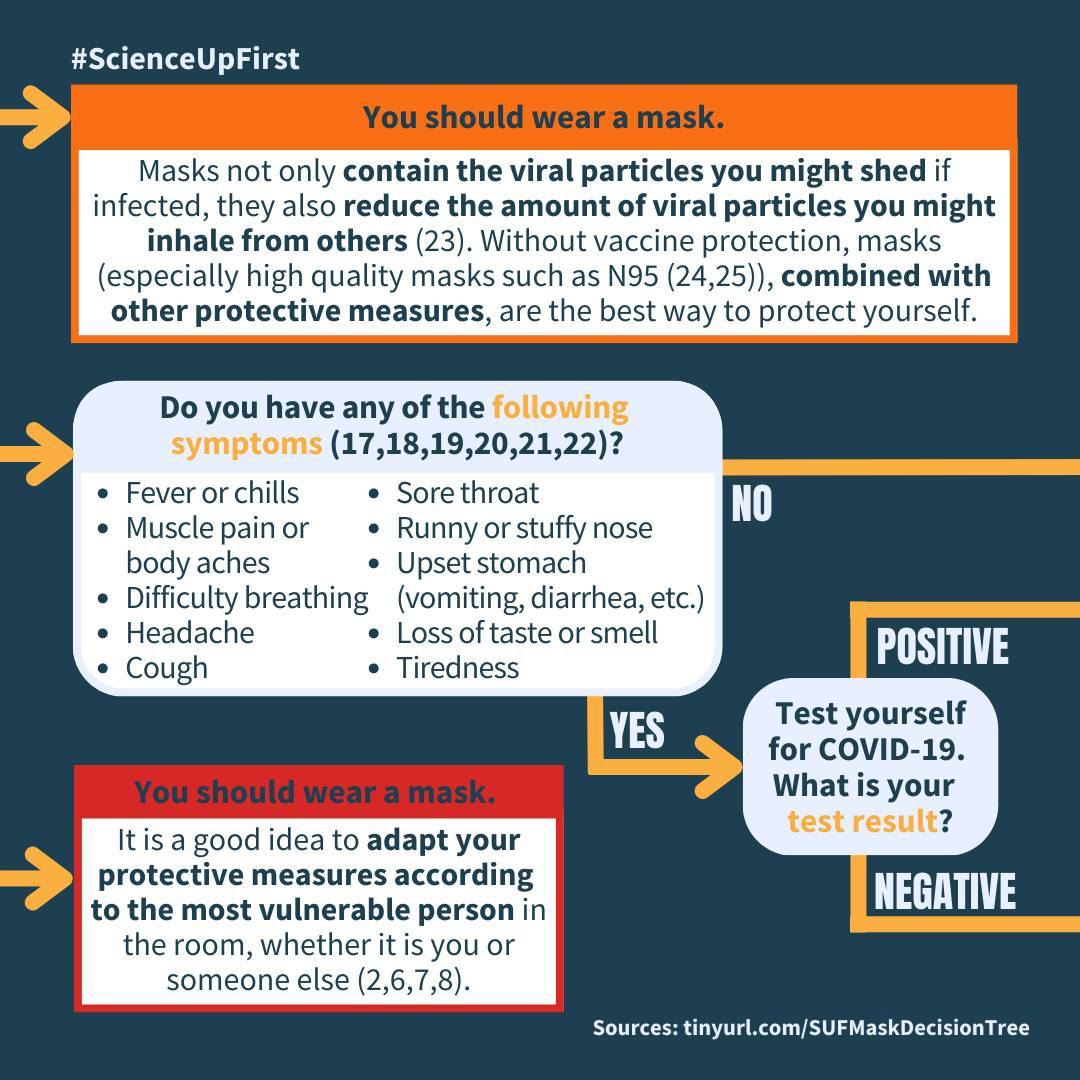
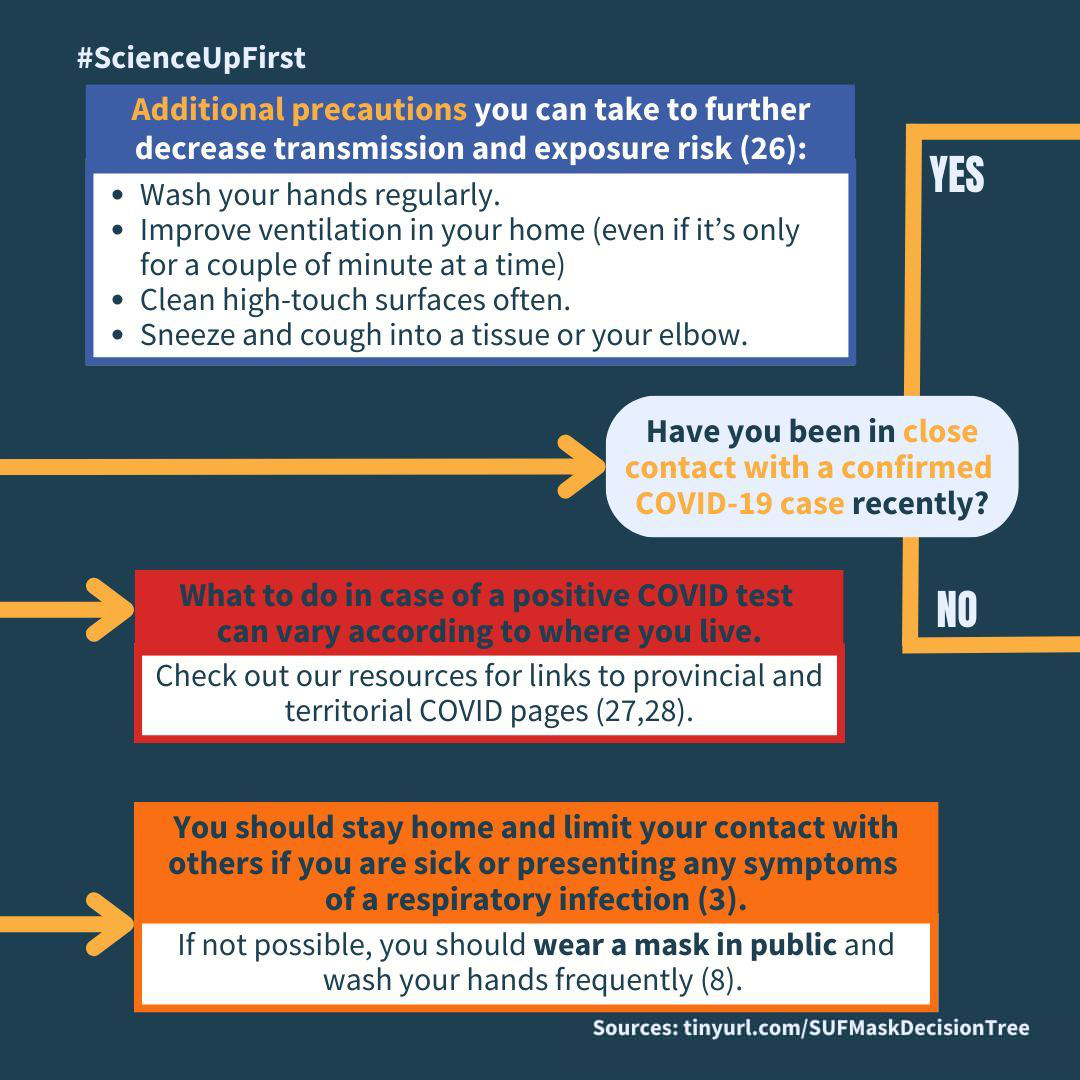

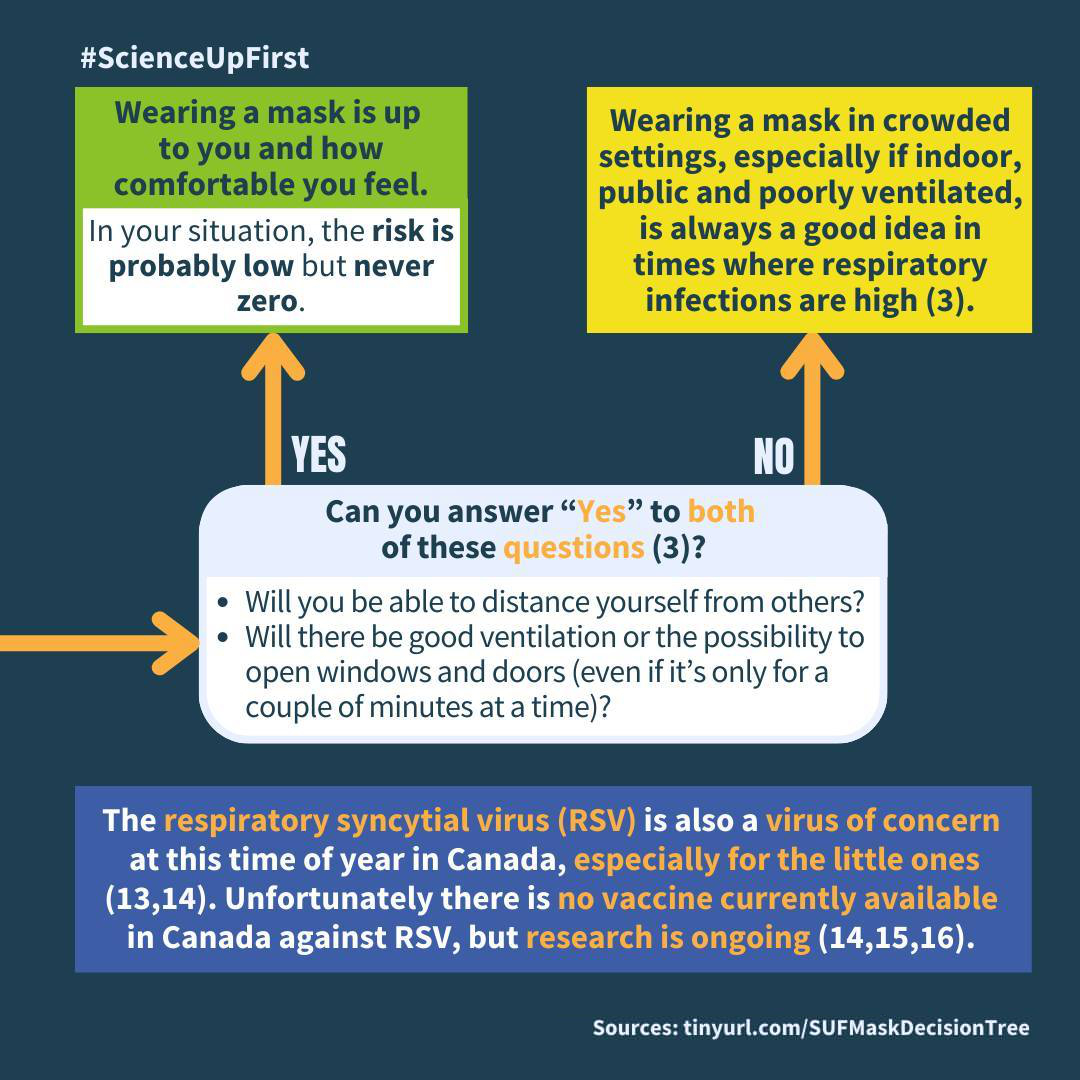
Should you mask up?
- Are you feeling uncomfortable or unsafe in the situation you are in?
- Yes (2)
- No (3)
- Even if masks are not mandatory anymore, you can still choose to wear one (1). Masks are not only making you feel safer, they are also effective at protecting against many respiratory infections transmitted via droplets in the air (2).
- Are you, or someone you will be in contact with, at risk of developing severe complications following a respiratory infection*?
- Yes (4)
- No (5)
*Someone is considered at higher risk of developing severe complication following a respiratory infection if they fit into one of the following categories (3,4,5):
- Younger than 5 years old
- 65 years and older
- Living with a chronic medical condition
- Residents of nursing homes and other chronic care facilities
- Pregnant
- Immunocompromised
- Member of the indigenous communities
- You should wear a mask. It is a good idea to adapt your protective measures according to the most vulnerable person in the room, whether it is you or someone else (2,6,7,8).
- Are you, and everyone present, up to date with the following vaccines** (9)?
- Yes (6)
- No or I’m not sure (7)
| Vaccine | Recommendation |
|---|---|
| COVID-19 | Anyone 6 months of age and older should receive a primary series and anyone 5 years of age and older can receive a booster dose if 6 months (minimum 3 months) have passed since their last vaccine dose or COVID-19 infection (10). |
| Influenza (the flu) | Annually to anyone 6 months of age and older, especially those who are or are in contact with higher risk individuals*, in contact with potentially infected poultry or providing essential community services (4). |
| Pneumococcal infection | All infants and children as part of their routine immunization, all individuals 65 years of age and older and all others at high risk of disease (11,12). |
**There are other pathogens and important vaccines, but we’ve included the most important seasonal respiratory diseases with approved vaccines.
- Fever or chills
- Muscle pain or body aches
- Difficulty breathing
- Headache
- Cough
- Sore throat
- Runny or stuffy nose
- Tiredness
- Loss of taste or smell
- Upset stomach (vomiting, diarrhea, etc.)
- Yes (8)
- No (11)
- Masks not only contain the viral particles you might shed if infected, they also reduce the amount of viral particles you might inhale from others (23). Without vaccine protection, masks (especially high quality masks such as N95 (24,25)), combined with other protective measures, are the best way to protect yourself.
Additional precautions you can take to further decrease transmission and exposure risk (26):
- Wash your hands regularly.
- Improve ventilation in your home (even if it’s only for a couple of minute at a time)
- Clean high-touch surfaces often.
- Sneeze and cough into a tissue or your elbow.
- Test yourself for COVID. What is your result?
- Positive (9)
- Negative (10)
- What to do in case of a positive COVID test can vary according to where you live. Check out our resources for links to provincial and territorial COVID pages (27,28).
- You should stay home and limit your contact with others if you are sick or presenting any symptoms of a respiratory infection (3). If not possible, you should wear a mask in public and wash your hands frequently (8).
- Have you been in close contact with a confirmed COVID-19 case recently?
- Yes (12)
- No (13)
- If no symptoms, wait at least 5 full days before self testing for the most accurate results (29). In the meantime, wearing a mask in public will help limit potential pre-symptomatic and asymptomatic transmission (20,30).
- Are the case numbers currently increasing in your area?
- Yes (14)
- No (15)
- Increased case numbers often means increased community transmission (31). Combined with the fact that people can be infectious a couple of days before showing any symptoms (20), wearing a mask in crowded spaces, especially indoors, is a good way to reduce your and others risk of infection (3).
- Will you be inside or outside?
- Outside (16)
- Inside (17)
- Outdoor gatherings are not considered a high risk situation as ventilation is optimal. There is still a risk if the space is crowded, so don’t hesitate to mask up (32).
- Can you answer “Yes” to both of these questions (3)?
- Will you be able to distance yourself from others?
- Will there be good ventilation or the possibility to open windows and doors (even if it’s only for a couple of minutes at a time)?
- Yes (18)
- No (19)
- Wearing a mask is up to you and how comfortable you feel. In your situation, the risk is probably low but never zero.
- Wearing a mask in crowded settings, especially if indoor, public and poorly ventilated, is always a good idea in times where respiratory infections are high (3).
The respiratory syncytial virus (RSV) is also a virus of concern at this time of year in Canada, especially for the little ones (13,14). Unfortunately there is no vaccine currently available in Canada against RSV, but research is ongoing (14,15,16).
Masks are a great tool to prevent the transmission of many viruses causing respiratory infections.
Wearing a mask in an indoor public setting can lower your risk of testing positive for COVID-19 significantly (33).
But it can be hard to decide when exactly is the best time to wear one. There are a few things to take into consideration:
- Your level of comfort
- Risk level, for you and your close contacts.
- Your current vaccine protection
- Presence of symptoms
- The number of cases in your area
- Where you will be gathering
- How crowded the space will be
Remember, an important part of mask-wearing is to respect others’ choices (1,23).
Share our original Tweet!
View our original Instagram Post!
- #MaskMakeSense Campaign
- Is It Time To Put On A Mask Again?
- Prevent the spread of respiratory viruses | FR : Prévention de la propagation des virus respiratoires
- Canadian Immunization Guide Chapter on Influenza and Statement on Seasonal Influenza Vaccine for 2022–2023 | FR : Chapitre sur la grippe du Guide canadien d’immunisation et Déclaration sur la vaccination antigrippale pour la saison 2022-2023
- Respiratory syncytial virus (RSV): Prevention and risks | FR : Virus respiratoire syncytial (VRS) : Prévention et risques
- Mask Use during COVID-19
- Use and Care of Masks
- Wearing a mask or a face covering | FR : Port du masque ou du couvre-visage
- My COVID-19 Visit Risk Calculator (2021 – 2022)
- FR : Ma calculatrice pour risque d’exposition à la COVID-19
- COVID-19 vaccine: Canadian Immunization Guide | FR : Vaccin contre la COVID-19 : Guide canadien d’immunisation
- COVID-19 Vaccines – What Older Canadians Need to Know
- Pneumococcal vaccine: Canadian Immunization Guide | FR : Vaccin contre le pneumocoque : Guide canadien d’immunisation
- Kids are getting hit hard by respiratory viruses. Here’s what scientists know — and what they don’t
- Respiratory syncytial virus (RSV): Prevention and risks | FR : Virus respiratoire syncytial (VRS) : Prévention et risques
- RSV treatment: What is palivizumab and are scientists close to creating a vaccine?
- GSK Canada submits respiratory syncytial virus (RSV) vaccine candidate for regulatory review
- Coronavirus disease (COVID-19) | FR : Coronavirus
- COVID-19: Symptoms, treatment, what to do if you feel sick | FR : COVID-19 : Symptômes, traitement, ce que vous devez faire si vous vous sentez malade
- Symptoms of COVID-19
- Similarities and Differences between Flu and COVID-19
- Respiratory syncytial virus (RSV) – Symptoms and causes
- Symptoms and Complications of Pneumococcal Disease
- COVID-19 mask use: Advice for community settings | FR : Utilisation du masque contre la COVID-19 : Conseils aux collectivités
- Efficacy of masks and face coverings in controlling outward aerosol particle emission from expiratory activities
- Should you wear a mask? Advice for navigating a mask-optional Canada
- Help reduce the spread of COVID-19 | FR : Contribuez à réduire la propagation de la COVID-19
- Provinces and territories: Taking action on COVID-19 | FR : Provinces et territoires : mesures prises contre la COVID-19
- COVID-19: Provincial and territorial resources | FR : COVID-19 : Ressources des provinces et des territoires
- COVID-19 Testing: What You Need to Know
- Symptoms, transmission and treatment (COVID-19) | FR : Symptômes, transmission et traitement (COVID-19)
- Community risk level & key metrics
- Should You Wear a Mask at Outdoor Events?
- Effectiveness of Face Mask or Respirator Use in Indoor Public Settings for Prevention of SARS-CoV-2 Infection

